Just over half of agricultural crime is reported to gardaí by the affected farmers, according to a new survey of 861 farmers. It found that in 55% of crime incidents the farmer reported to gardaí while in 45% of cases the incident was not reported. The level of recovery of stolen assets is very low, it found. In fact, respondents recorded fewer assets as being recovered by gardaí than by other means.
The findings are in a survey on agricultural crime commissioned by the ICSA. It looks at reporting of agricultural crime to the gardaí and at crime prevention measures used by farmers. Agricultural crime was categorised into:
Vandalism, criminal damage and trespass (VCDT).Theft.Criminal assault.Fraud on farming activities.More incidents of theft and criminal assault were reported to gardaí than not reported. In contrast, a minority of incidents of VCDT and fraud were reported. Theft and VCDT were more likely to be reported when the asset was insured.
Almost nine out of 10 respondents employed at least one crime prevention measure. The most popular were locking gates and use of a dog. Other measures included locking up equipment, locking gates or otherwise securing land or buildings, recording serial numbers or tag numbers, and use of warning signs.
The authors state that this is the first such survey and that it will form a baseline for future studies.
Victimisation of farmers
Approximately two thirds of farmers had experienced crime in the 30 months to mid-2016. These farmers break down as 25% experiencing just one incident, with the other 41% two or more. The most common types of crime were those coming under the heading of vandalism, criminal damage and trespass (VCDT). These were 47% of all crimes. Next was theft at 43%. Criminal assault and fraud were substantially lower at 5% each.
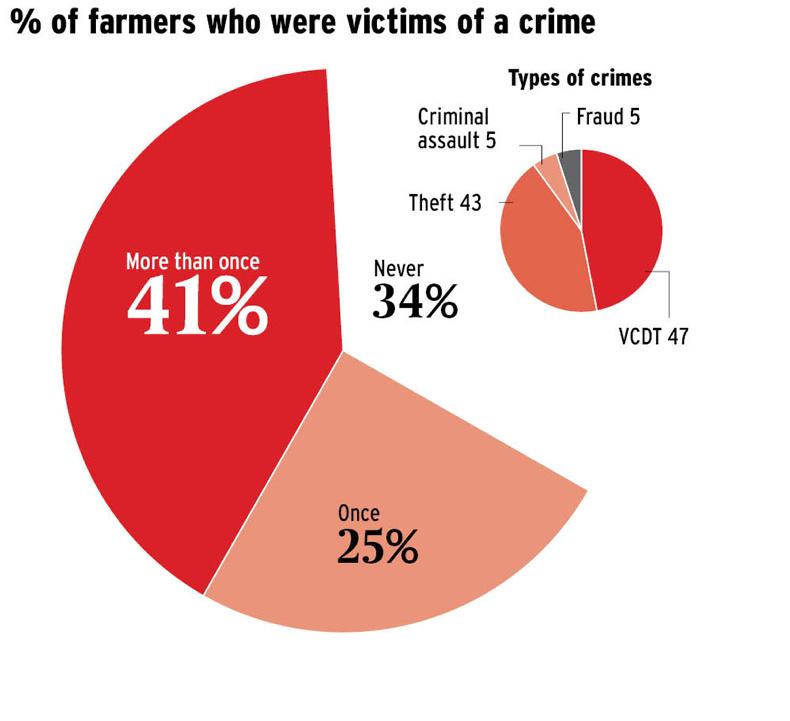
Reporting to gardaí
Overall, more crimes were reported to Gardai (55%) than were not (45%). Where the crime was theft, nearly two thirds (63%) were reported.
For criminal assault, 71% were reported. Conversely, where the crime was VCDT or fraud, most were not reported.
For VCDT, less than half (47%) of incidents were reported, for fraud only 26% were.
Value of stolen items
Where a theft was reported to gardaí, the value of the stolen items averaged €2,365. Where theft was not reported, average value was €1,861. Where the crime was robbery involving force or threat of force, all incidents were reported to gardaí and average value was €4,375.
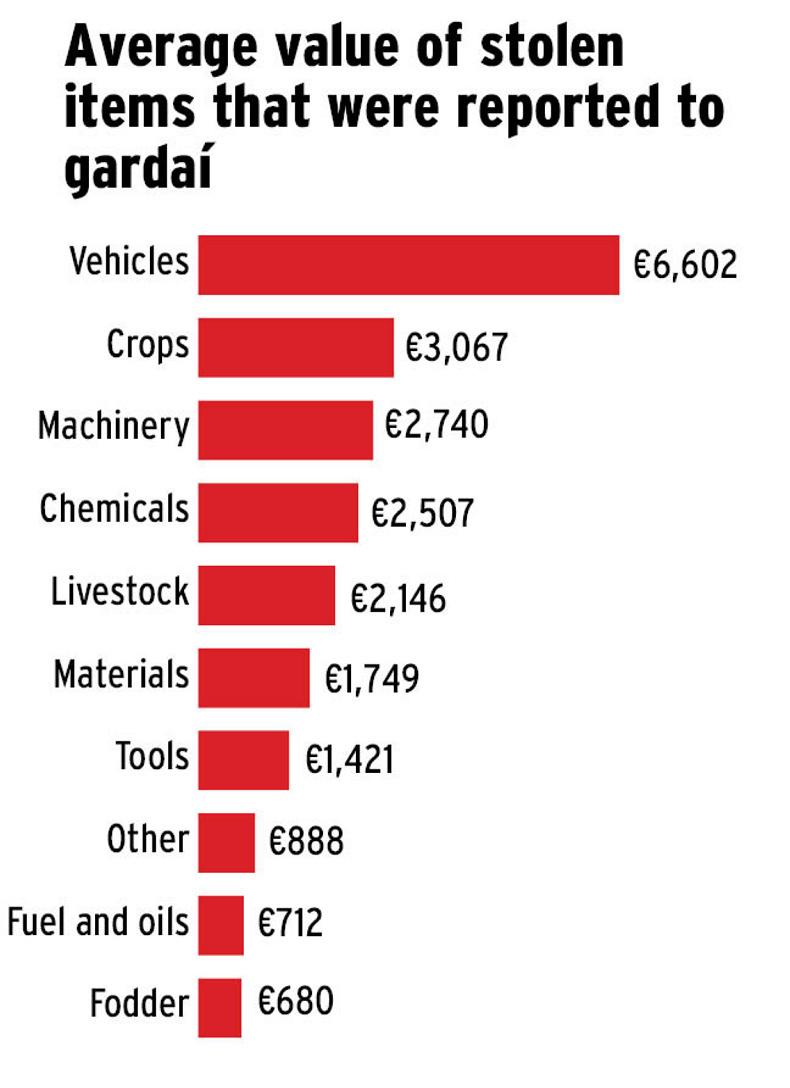
Diesel most often stolen
Fuel and oils were the items most commonly stolen, with the bulk of this accounted for by theft of green diesel. Exactly half of thefts of green diesel were reported to gardaí. The average value of diesel reported stolen was €705 compared with an average value of €415 where the crime was not reported.
Among these categories, the stolen items with the highest average values were vehicles, crops and chemicals. Where theft of vehicles was reported to Gardaí, the average value was €6,602. Where not reported, it was €1,238.
Where theft of crops was reported, average value was €3,067, where not reported €589. Where theft of chemicals was reported, average value was €2,507, where not reported €115.
Recovery of stolen items
The survey found that recovery of stolen items was rare. Of the 554 thefts which were reported to gardaí, items were recovered, fully or partially, in 55 of these cases. Gardaí were involved in 21 of these recoveries, but not in the other 34.
The category of item most often recovered was vehicles. There were 52 such thefts reported to gardaí and in 18 of these thefts assets were recovered.
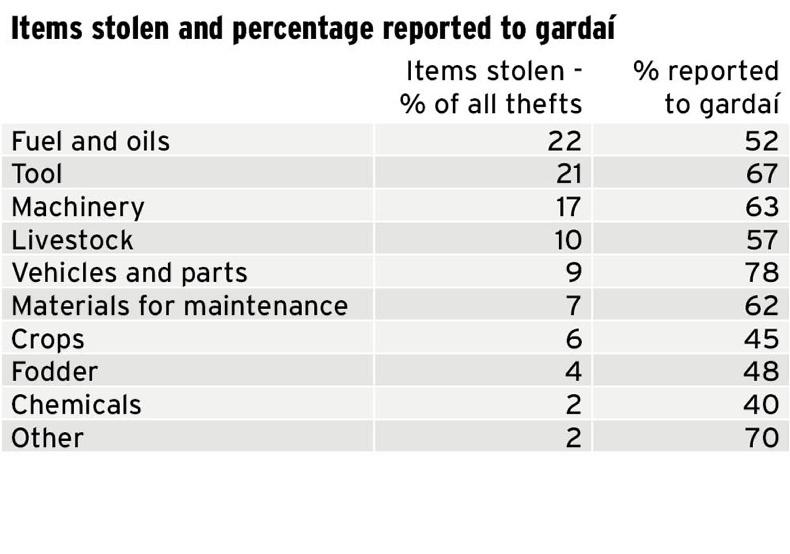
Trespass
Farmers provided details for 561 incidents under the heading of vandalism, criminal damage or trespass. Trespass made up nearly two-thirds (65%) of these cases. They were quite evenly divided between poaching, dumping and general trespass. Farmers reported 44% of trespass incidents to gardaí but not the other 56%. Vandalism to personal property and land were less frequent than trespass.
The financial costs arising from trespass were relatively low. Higher costs arose from vandalism to personal property. For example, in trespass cases reported to gardaí:
Average loss after poaching was €680.From dumping €473Other trespass €318. In contrast, where vandalism to personal property was reported to gardaí, the losses were:
€2,506 for livestock.€2,453 for vehicles, machinery, equipment.€1,033 for tools. 
Prevention measures
Nine out of 10 farmers used some crime prevention measures. There was some linkage between use of a prevention measure and likelihood of being a crime victim. Almost all farmers (99%) who had not experienced a crime used one or more prevention measures. In contrast, 83% of farmers who experienced a crime use one or more measures.
When farmers were asked about securing their land and yards, it emerged that:
70% locked gates.41% erected fencing.42% used lighting. 18% used cameras, including fake ones. 17% used alarms, including fake ones. 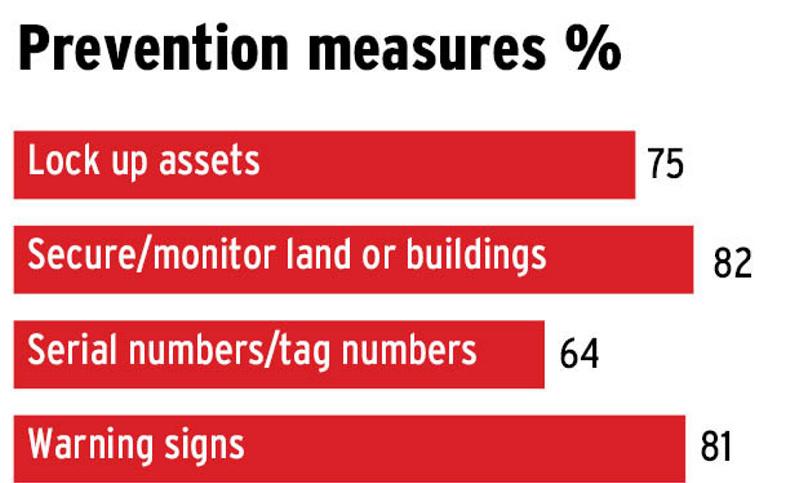
Other popular steps included:
Notifying someone if going away from the farm. 30% did so if staying away for one OR more nights. 20% created a sound in an unoccupied farm house, 8% did so for an unoccupied yard. 39% left on lights in the house when empty, 25% in the yard or sheds. Half (52%) of the farmers had a dog. 20% had “No dumping” signs and 40% “No trespassing” signs.A quarter took part in a community based crime prevention scheme.
Just over half of agricultural crime is reported to gardaí by the affected farmers, according to a new survey of 861 farmers. It found that in 55% of crime incidents the farmer reported to gardaí while in 45% of cases the incident was not reported. The level of recovery of stolen assets is very low, it found. In fact, respondents recorded fewer assets as being recovered by gardaí than by other means.
The findings are in a survey on agricultural crime commissioned by the ICSA. It looks at reporting of agricultural crime to the gardaí and at crime prevention measures used by farmers. Agricultural crime was categorised into:
Vandalism, criminal damage and trespass (VCDT).Theft.Criminal assault.Fraud on farming activities.More incidents of theft and criminal assault were reported to gardaí than not reported. In contrast, a minority of incidents of VCDT and fraud were reported. Theft and VCDT were more likely to be reported when the asset was insured.
Almost nine out of 10 respondents employed at least one crime prevention measure. The most popular were locking gates and use of a dog. Other measures included locking up equipment, locking gates or otherwise securing land or buildings, recording serial numbers or tag numbers, and use of warning signs.
The authors state that this is the first such survey and that it will form a baseline for future studies.
Victimisation of farmers
Approximately two thirds of farmers had experienced crime in the 30 months to mid-2016. These farmers break down as 25% experiencing just one incident, with the other 41% two or more. The most common types of crime were those coming under the heading of vandalism, criminal damage and trespass (VCDT). These were 47% of all crimes. Next was theft at 43%. Criminal assault and fraud were substantially lower at 5% each.

Reporting to gardaí
Overall, more crimes were reported to Gardai (55%) than were not (45%). Where the crime was theft, nearly two thirds (63%) were reported.
For criminal assault, 71% were reported. Conversely, where the crime was VCDT or fraud, most were not reported.
For VCDT, less than half (47%) of incidents were reported, for fraud only 26% were.
Value of stolen items
Where a theft was reported to gardaí, the value of the stolen items averaged €2,365. Where theft was not reported, average value was €1,861. Where the crime was robbery involving force or threat of force, all incidents were reported to gardaí and average value was €4,375.

Diesel most often stolen
Fuel and oils were the items most commonly stolen, with the bulk of this accounted for by theft of green diesel. Exactly half of thefts of green diesel were reported to gardaí. The average value of diesel reported stolen was €705 compared with an average value of €415 where the crime was not reported.
Among these categories, the stolen items with the highest average values were vehicles, crops and chemicals. Where theft of vehicles was reported to Gardaí, the average value was €6,602. Where not reported, it was €1,238.
Where theft of crops was reported, average value was €3,067, where not reported €589. Where theft of chemicals was reported, average value was €2,507, where not reported €115.
Recovery of stolen items
The survey found that recovery of stolen items was rare. Of the 554 thefts which were reported to gardaí, items were recovered, fully or partially, in 55 of these cases. Gardaí were involved in 21 of these recoveries, but not in the other 34.
The category of item most often recovered was vehicles. There were 52 such thefts reported to gardaí and in 18 of these thefts assets were recovered.

Trespass
Farmers provided details for 561 incidents under the heading of vandalism, criminal damage or trespass. Trespass made up nearly two-thirds (65%) of these cases. They were quite evenly divided between poaching, dumping and general trespass. Farmers reported 44% of trespass incidents to gardaí but not the other 56%. Vandalism to personal property and land were less frequent than trespass.
The financial costs arising from trespass were relatively low. Higher costs arose from vandalism to personal property. For example, in trespass cases reported to gardaí:
Average loss after poaching was €680.From dumping €473Other trespass €318. In contrast, where vandalism to personal property was reported to gardaí, the losses were:
€2,506 for livestock.€2,453 for vehicles, machinery, equipment.€1,033 for tools. 
Prevention measures
Nine out of 10 farmers used some crime prevention measures. There was some linkage between use of a prevention measure and likelihood of being a crime victim. Almost all farmers (99%) who had not experienced a crime used one or more prevention measures. In contrast, 83% of farmers who experienced a crime use one or more measures.
When farmers were asked about securing their land and yards, it emerged that:
70% locked gates.41% erected fencing.42% used lighting. 18% used cameras, including fake ones. 17% used alarms, including fake ones. 
Other popular steps included:
Notifying someone if going away from the farm. 30% did so if staying away for one OR more nights. 20% created a sound in an unoccupied farm house, 8% did so for an unoccupied yard. 39% left on lights in the house when empty, 25% in the yard or sheds. Half (52%) of the farmers had a dog. 20% had “No dumping” signs and 40% “No trespassing” signs.A quarter took part in a community based crime prevention scheme. 













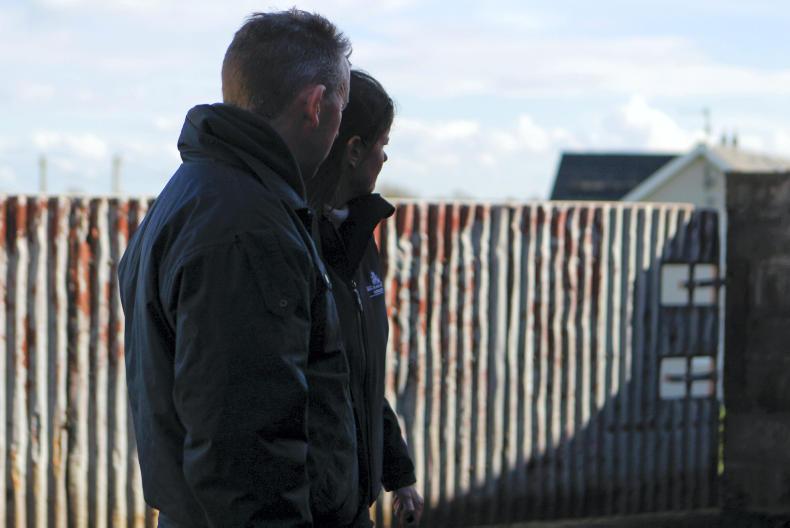
SHARING OPTIONS